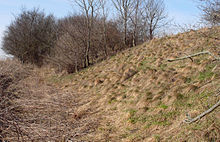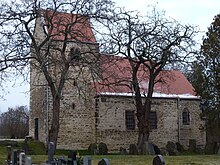Treben (desert)
Treben is a desert near Dehlitz (Saale) in the Burgenland district in Saxony-Anhalt .
From the former village, only the 12th century church has survived, which stands on a hill above the confluence of the Rippach and the Saale . Some Slavic burial sites made of brown coal quartzite have also been preserved . The settlement was protected by two walls, the inner wall of which is still partially preserved. The outer wall was leveled by farming.
origin of the name
The name Treben (also dribani, tribani or trebani) possibly goes back to the Slavic word "treba", which means "sacrifice". The obvious words trebiniku or trebiniki mean sanctuary and altar. There may have been a Slavic sacrificial site at the height above the Rippach confluence with the Saale. Ernst Eichler and Hans Walther, however, interpret “treba” as “clearing”. That seems pretty obvious in view of the presorbian immigration situation.
history
The earliest traces of settlement date from the younger Stone Age . Finds of vessels, stone axes and awls from Rehknochen suggest that the first settlers were hunters and operated no agriculture. Other finds of broken glass and a roller-head needle date from the late Bronze Age. They were about 70 to 100 centimeters deep in the ground. In the 9th century the Carolingians had wall castles built on both banks of the Saale , one of which was Treben. It is documented that Otto II stayed with his court in Treben in 979. In 1108, Heinrich V gave the Bishop of Meissen nine mansions in Treben. In 1287 the village fell to the Poor Clare Monastery in Weißenfels . After Treben were u. a. Kleben, Lösau and Nellschütz parish. In 1555 the last pastor of Treben and the sexton moved into their own house in Pörsten . The fields of the village, abandoned in 1555, were sold to the surrounding towns in 1594.
The church
The parish Treben is mentioned for the first time in a document from 1041 , which means that a parish church stood there at that time . The church, built in Romanesque style, has undergone various changes over the centuries, but the Romanesque windows can still be seen in the walls. In 1739 the church was restored. The church has a door on the west side that was probably built into the tower at a later date, behind which you have to climb about 70 centimeters in order to reach the level of the church floor. The late Gothic winged altar by Stephan Hermsdorf is unusual in its size and artistic quality for village churches of this type . The figures are related to the Poor Clare Monastery in Weißenfels or the diocese of Merseburg .
literature
- Johannes Burkhardt , Otto Küstermann : Descriptive representation of the older architectural and art monuments of the Merseburg district. Hendel, Halle / Saale 1883, pp. 233-234.
- Joachim Zaumseil: The Treben desert northeast of Weißenfels . In: Saale-Unstrut-Yearbook . 10, 2005, 1, ISSN 1431-0791 , p. 153.
- Mike Sachse: The ramparts of the Treben desert . In: Weißenfelser Heimatbote NF 1, 1992, 3, ZDB -ID 1285297-1 , pp. 12-13.
Individual evidence
- ↑ Ernst Eichler , Hans Walther : Investigations on toponymy and language and settlement history of the area between the middle Saale and White Elster . Berlin 1984, p. 312 .
Coordinates: 51 ° 13 ′ 46 ″ N , 12 ° 1 ′ 2 ″ E


